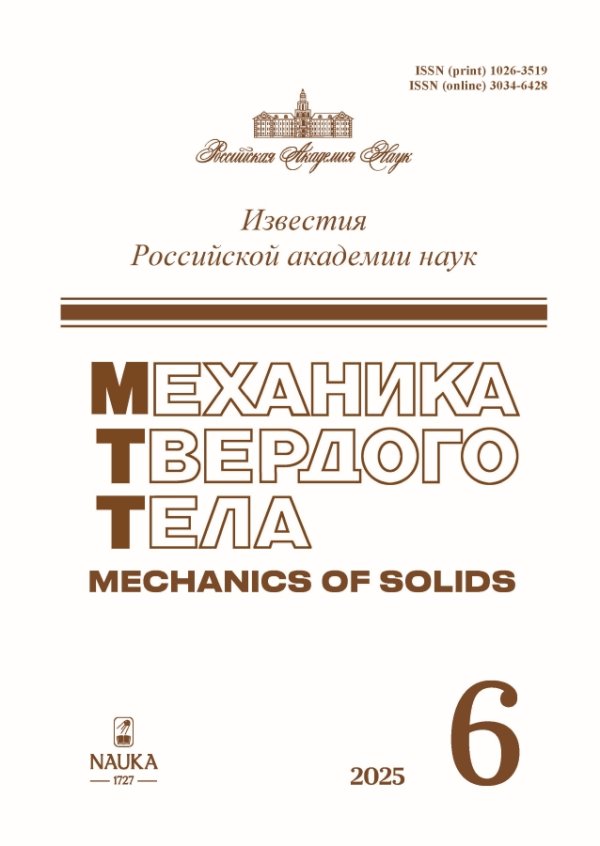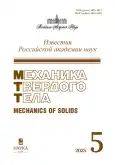Biomechanical Modeling of Osteotomies of the First Metatarsal Bone in Normal and Osteoporotic Conditions
- Authors: Maryankin K.A.1, Magomedov I.M.1, Bessonov L.V.1, Dol A.V.1, Kireev S.I.1, Ivanov D.V.1
-
Affiliations:
- Saratov National Research State University named after N.G. Chernyshevsky
- Issue: No 5 (2025)
- Pages: 109-123
- Section: Articles
- URL: https://medbiosci.ru/1026-3519/article/view/315576
- DOI: https://doi.org/10.31857/S1026351925050063
- EDN: https://elibrary.ru/bvlosg
- ID: 315576
Cite item
Abstract
Hallux valgus is a widespread pathology. Osteotomy of the first metatarsal bone is the gold standard for its treatment. The success of this surgical intervention depends, among other factors, on the stability of the “bone-fixation” system. Previous studies assessing the biomechanical properties of various first metatarsal osteotomies have examined the influence of osteotomy type, degree of fragment displacement, as well as the number and positioning of screws. In these studies, the biomechanical properties of bone tissue corresponded to normal values of conventionally healthy patients. Older patients are characterized by a high prevalence of osteoporosis. This disease manifests in reduced mineral density and mechanical properties of bone. The effect of osteoporosis on the biomechanical parameters of first metatarsal osteotomy models has not been previously studied. The aim of this work was to evaluate the stability of first metatarsal osteotomies under normal bone density and osteoporotic conditions, as well as to assess the robustness of biomechanical models of the most common osteotomy types to minor variations in screw positioning and bone-cutting plane geometry. For this purpose, 36 biomechanical models of scarf and chevron osteotomies were created, varying screw placement, bone-cutting plane geometry, cortical thickness, and elastic modulus. Finite element analysis was used to assess the stress-strain state of the osteotomy models. Model validation was performed based on natural cantilever bending tests of first metatarsal osteotomies in universal testing machine. The study demonstrated the robustness of scarf and chevron osteotomy models to minor changes in geometric parameters. Chevron osteotomy proved more stable than scarf. Additionally, scarf osteotomy generated significantly higher bone stresses compared to chevron. It was found that even under osteoporotic conditions, both osteotomy types can provide sufficient stability and strength in terms of screw breakage and bone tissue damage.
Keywords
About the authors
K. A. Maryankin
Saratov National Research State University named after N.G. Chernyshevsky
Email: ivanovdv.84@yandex.ru
Saratov, Russia
I. M. Magomedov
Saratov National Research State University named after N.G. Chernyshevsky
Email: ivanovdv.84@yandex.ru
Saratov, Russia
L. V. Bessonov
Saratov National Research State University named after N.G. Chernyshevsky
Email: ivanovdv.84@yandex.ru
Saratov, Russia
A. V. Dol
Saratov National Research State University named after N.G. Chernyshevsky
Email: ivanovdv.84@yandex.ru
Saratov, Russia
S. I. Kireev
Saratov National Research State University named after N.G. Chernyshevsky
Author for correspondence.
Email: ivanovdv.84@yandex.ru
Saratov, Russia
D. V. Ivanov
Saratov National Research State University named after N.G. Chernyshevsky
Email: ivanovdv.84@yandex.ru
Saratov, Russia
References
- Favre P., Farine M., Snedeker J.G., Maquieira G.J., Espinosa N. Biomechanical consequences of first metatarsal osteotomy in treating hallux valgus // Clinical Biomechanics. 2010. V. 25. № 7. P. 721–727. https://doi.org/10.1016/j.clinbiomech.2010.05.002
- Polienko A.V., Ivanov D.V., Kireev S.I., Bessonov L.V., Muldasheva A.M., Olenko E.S. Numerical analysis of stress-strain state in first metatarsal osteotomies // Izvestiya Saratovskogo Universiteta. Novaya Seriya. Seriya: Matematika. Mekhanika. Informatika. 2023. V. 23. № 4. P. 496–511. https://doi.org/10.18500/1816-9791-2023-23-4-496-511
- Golyadkina A.A., Polienko A.V., Kireev S.I., Kurmanov A.G., Kireev V.S. Analysis of biomechanical parameters of first metatarsal osteotomy // Russian Journal of Biomechanics. 2019. V. 23. № 3. P. 400–410. https://doi.org/10.15593/RZhBiomeh/2019.3.06
- Li Y., Wang Y., Tang K., Tao X. Modified scarf osteotomy for hallux valgus: From a finite element model to clinical results // J. Orthop. Surg. 2022. V. 30. № 3. 10225536221143816. https://doi.org/10.1177/10225536221143816
- Shih K.S., Hsu C.C., Huang G.T. Biomechanical Investigation of Hallux Valgus Deformity Treated with Different Osteotomy Methods and Kirschner Wire Fixation Strategies Using the Finite Element Method // Bioengineering (Basel). 2023. V. 10. № 499. https://doi.org/10.3390/bioengineering10040499
- Xie Q., Li X., Wang P. Three-dimensional finite element analysis of biomechanics of osteotomy ends with three different fixation methods after hallux valgus minimally invasive osteotomy // J. Orthop. Surg. 2023. V. 31. № 2. 10225536231175235. https://doi.org/10.1177/10225536231175235
- Kim J.S., Cho H.K., Young K.W., Kim J.S., Lee K.T. Biomechanical Comparison Study of Three Fixation Methods for Proximal Chevron Osteotomy of the First Metatarsal in Hallux Valgus // Clin. Orthop. Surg. 2017. V. 9. № 4. P. 514–520. https://doi.org/10.4055/cios.2017.9.4.514
- Esses S.I., McGuire R., Jenkins J., Finkelstein J., Woodard E., Watters W.C. III et al. The treatment of symptomatic osteoporotic spinal compression fractures // Am. Acad. Orthop. Surg. 2011. V. 19. № 3. P. 176–182. https://doi.org/10.2106/JBJS.9320ebo
- Kang S., Park C.H., Jung H., Lee S., Min Y.S., Kim C.H. et al. Analysis of the physiological load on lumbar vertebrae in patients with osteoporosis: a finite-element study // Sci Rep. 2022. V. 12. № 1. P. 11001. https://doi.org/10.1038/s41598-022-15241-3
- Seeman E. Reduced bone formation and increased bone resorption: rational targets for the treatment of osteoporosis // Osteoporos Int. 2003. V. 14. Suppl 3. P. S2–S8. https://doi.org/10.1007/s00198-002-1340-9
- Zhang Y., Awrejcewicz J., Szymanowska O., Shen S., Zhao X., Baker J.S., Gu Y. Effects of severe hallux valgus on metatarsal stress and the metatarsophalangeal loading during balanced standing: A finite element analysis // Comput. Biol. Med. 2018. V. 97. P. 1–7. https://doi.org/10.1016/j.compbiomed.2018.04.010
- Ivanov D.V., Dol A.V., Bessonov L.V., Kireev S.I., Gulyaeva A.O. Methodology for mechanical testing of metatarsal bones under cantilever loading // Russian Journal of Biomechanics. 2023. V. 27. № 4. P. 84–92. https://doi.org/10.15593/RZhBiomeh/2023.4.06
- Deenik A.R., Pilot P., Brandt S.E., van Mameren H., Geesink R.G., Draijer W.F. Scarf versus chevron osteotomy in hallux valgus: a randomized controlled trial in 96 patients // Foot Ankle Int. 2007. V. 28. № 3. P. 537–541. https://doi.org/10.3113/FAI.2007.0537
- Ma Q., Liang X., Lu J. Chevron osteotomy versus scarf osteotomy for hallux valgus correction: A meta-analysis // Foot Ankle Surg. 2019. V. 25. № 6. P. 755–760. https://doi.org/10.1016/j.fas.2018.09.003
- Sun X., Guo Z., Cao X., Xiong B., Pan Y., Sun W., Bai Z. Stability of osteotomy in minimally invasive hallux valgus surgery with “8” shaped bandage during gait: a finite element analysis // Front. Bioeng. Biotechnol. 2024. V. 12. P. 1415617. https://doi.org/10.3389/fbioe.2024.1415617
- Kim J.S., Cho H.K., Young K.W., Kim J.S., Lee K.T. Biomechanical comparison study of three fixation methods for proximal chevron osteotomy of the first metatarsal in hallux valgus // Clin. Orthop. Surg. 2017. V. 9. № 4. P. 514–520. https://doi.org/10.4055/cios.2017.9.4.514
- Havaldar R., Pilli S.C., Putti B.B. Insights into the effects of tensile and compressive loadings on human femur bone // Adv. Biomed. Res. 2014. V. 3. № 101. https://doi.org/10.4103/2277-9175.129375
- Ivanov D.V. Biomechanical support for clinical decision-making in treatment selection based on quantitative success criteria // Izvestiya Saratovskogo Universiteta. Novaya Seriya. Seriya: Matematika. Mekhanika. Informatika. 2022. V. 22. № 1. P. 62–89. https://doi.org/10.18500/1816-9791-2022-22-1-62-89
- Gulyaeva A.O., Falkovich A.S., Kireev S.I., Terin D.V., Magomedov I.M. Study of the relationship between plantar pressure and calf muscle tone. Development and testing of a new experimental setup // Russian Journal of Biomechanics. 2023. V. 27. № 4. P. 127–137. https://doi.org/10.15593/RZhBiomeh/2023.4.10
Supplementary files










